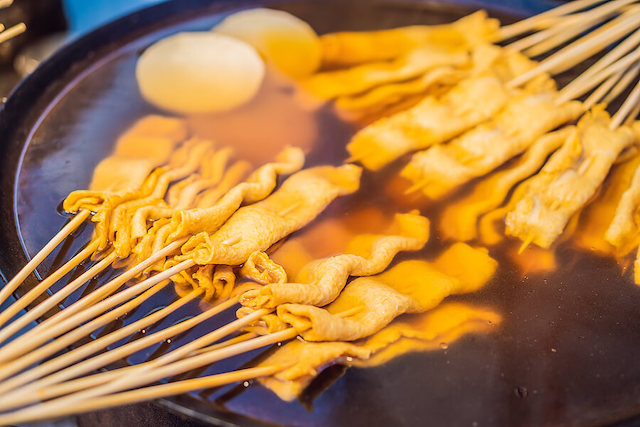If there’s one thing Koreans and tourists both agree on, it’s that Korean street food is a must-try! It also helps that markets and food streets abound, so you can easily find tasty snacks and even quick meals from these bustling stalls. Looking for supper or some snacks to go with beer? Street food is the way to go!
Street food and snacks in Korea range from the traditional to the more hipster concoctions. If you’re spoilt for choice, or aren’t sure what all the Korean names mean, do not fret! Here’s a quick preview of some yummy treats you can get at Korean food streets.
1. Hotteok
The name ‘hotteok’ actually sounds a bit like ‘hotdog’, but it is anything but that. Hotteoks are a sort of stuffed pancake, usually on the sweet side (in contrast to jeon, the savoury pancakes), grilled or fried to perfection with a crisp outside and soft inside. Served piping hot, it is particularly popular in the winter months. Traditional fillings typically include cinnamon, red beans, or honey syrup, but there are also plenty of other variations in different regions of the country.
2. Kimbap
Often compared to the sushi, kimbap is Korea’s solution to a handheld meal. Rice and cooked ingredients such as egg, cucumber, pickled radish, and meat are wrapped in a dried seaweed sheet to produce this snack. The rice is seasoned with sesame oil, giving it a distinct flavour, unlike sushi, which is vinegar-seasoned. Due to its portable nature, it is frequently eaten as a snack or light meal, convenient for packed lunches.
3. Chimaek
Fried chicken might not sound too exotic, but when you’ve tried Korean fried chicken, you’ll understand why it’s a top pick amongst street food fans. Unlike the usual fast food fried chicken we know of (think KFC), Korean fried chicken has a generous slathering of sauce glaze, usually of some mixture of soy sauce and spicy sauce, which gives it a strong, addictive burst of flavours. Chimaek refers to the popular combination of fried chicken (chikin) with beer (maekju), usually enjoyed as a late-night snack.
4. Odeng, or Eomuk
If you’re looking for something warm and comforting, this should hit the spot. Odeng is Korea’s version of fish cake, made of fish paste, starch, flour, rice wine, and various spices. Most commonly, you will see odeng sold on skewers, accompanied with a warm, savoury broth. Also called eomuk, some stalls serve the fish cake with chilis and green onion, and yet others sell a fried version of them.
The streets of Korea are teeming with plenty of delectable snacks – of which we’ve only covered a small slice of the whole pie! The best way to experience it for yourself is to be in Korea to taste them all!
Having a basic grasp of the Korean language can be a great help throughout your food tour experience, given that many stall owners are local elderly with limited knowledge of English. If you’re planning to explore Korea’s street food on your next holiday, it will be a good idea to take up a Korean language course today to learn the language! Sejong Korean Language School offers courses for various levels so anyone can learn and improve at a pace that’s comfortable for them.


